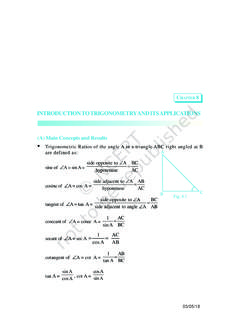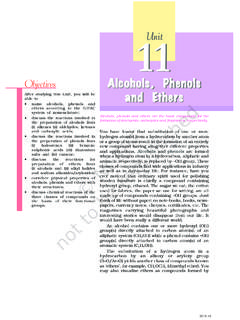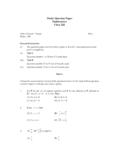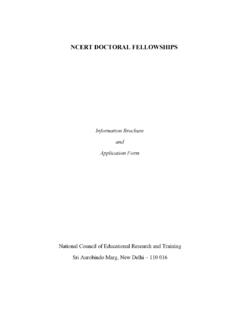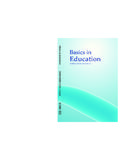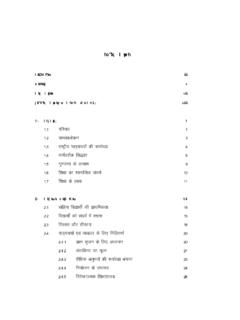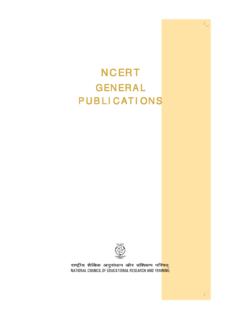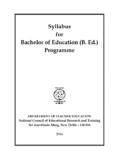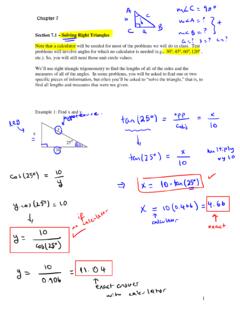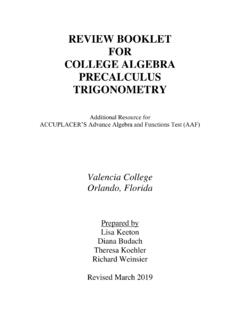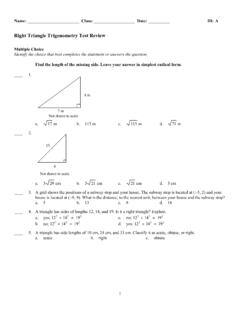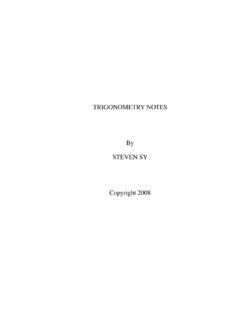Transcription of INTRODUCTION TRIGONOMETRY TO 8 - NCERT
1 INTRODUCTION TO TRIGONOMETRY1738 There is perhaps nothing which so occupies themiddle position of mathematics as TRIGONOMETRY . Herbart (1890) have already studied about triangles, and in particular, right triangles, in yourearlier classes. Let us take some examples from our surroundings where right trianglescan be imagined to be formed. For instance the students of a school arevisiting Qutub Minar. Now, if a studentis looking at the top of the Minar, a righttriangle can be imagined to be made,as shown in Fig Can the studentfind out the height of the Minar, withoutactually measuring it? 2. Suppose a girl is sitting on the balconyof her house located on the bank of ariver. She is looking down at a flowerpot placed on a stair of a temple situatednearby on the other bank of the right triangle is imagined to be madein this situation as shown in Ifyou know the height at which theperson is sitting, can you find the widthof the river?
2 INTRODUCTION TOTRIGONOMETRYFig. a hot air balloon is flying inthe air. A girl happens to spot theballoon in the sky and runs to hermother to tell her about it. Her motherrushes out of the house to look at when the girl had spottedthe balloon intially it was at point both the mother and daughtercame out to see it, it had alreadytravelled to another point B. Can youfind the altitude of B from the ground?In all the situations given above, the distances or heights can be found by usingsome mathematical techniques, which come under a branch of mathematics called TRIGONOMETRY . The word TRIGONOMETRY is derived from the Greek words tri (meaning three), gon (meaning sides) and metron (meaning measure). In fact, TRIGONOMETRY is the study of relationships between the sides and angles of a earliest known work on TRIGONOMETRY was recorded in Egypt and Babylon.
3 Earlyastronomers used it to find out the distances of the stars and planets from the today, most of the technologically advanced methods used in Engineering andPhysical Sciences are based on trigonometrical this chapter, we will study some ratios of the sides of a right triangle withrespect to its acute angles, called trigonometric ratios of the angle. We will restrictour discussion to acute angles only. However, these ratios can be extended to otherangles also. We will also define the trigonometric ratios for angles of measure 0 and90 . We will calculate trigonometric ratios for some specific angles and establishsome identities involving these ratios, called trigonometric RatiosIn Section , you have seen some right trianglesimagined to be formed in different us take a right triangle ABC as shownin Fig.
4 , CAB (or, in brief, angle A) is anacute angle. Note the position of the side BCwith respect to angle A. It faces A. We call itthe side opposite to angle A. AC is thehypotenuse of the right triangle and the side ABis a part of A. So, we call it the sideadjacent to angle 22 INTRODUCTION TO TRIGONOMETRY175 Note that the position of sides changewhen you consider angle C in place of A(see Fig. ).You have studied the concept of ratio inyour earlier classes. We now define certain ratiosinvolving the sides of a right triangle , and callthem trigonometric trigonometric ratios of the angle Ain right triangle ABC (see Fig. ) are definedas follows :sine of A = side opposite to angle ABChypotenuseAC=cosine of A = side adjacent to angle AABhypotenuseAC=tangent of A = side opposite to angle ABCside adjacent to angle AAB=cosecant of A = 1hypotenuseACsine ofAside opposite to angle ABC== secant of A = 1hypotenuseACcosine ofAside adjacent to angle AAB== cotangent of A = 1side adjacent to angle AABtangent ofAside opposite to angle ABC== The ratios defined above are abbreviated as sin A, cos A, tan A, cosec A, sec Aand cot A respectively.
5 Note that the ratios cosec A, sec A and cot A are respectively,the reciprocals of the ratios sin A, cos A and tan , observe that tan A = BCBCsin AACABABcos AAC== and cot A = cos Asin , the trigonometric ratios of an acute angle in a right triangle express therelationship between the angle and the length of its don t you try to define the trigonometric ratios for angle C in the righttriangle? (See Fig. )Fig. 22176 MATHEMATICSThe first use of the idea of sine in the way we useit today was in the work Aryabhatiyam by Aryabhata,in 500. Aryabhata used the word ardha-jyafor the half-chord, which was shortened to jya orjiva in due course. When the Aryabhatiyam wastranslated into Arabic, the word jiva was retained asit is. The word jiva was translated into sinus, whichmeans curve, when the Arabic version was translatedinto Latin.
6 Soon the word sinus, also used as sine,became common in mathematical texts throughoutEurope. An English Professor of astronomy EdmundGunter (1581 1626), first used the abbreviatednotation sin .The origin of the terms cosine and tangent was much later. The cosine functionarose from the need to compute the sine of the complementary angle. Aryabhattacalled it kotijya. The name cosinus originated with Edmund Gunter. In 1674, theEnglish Mathematician Sir Jonas Moore first used the abbreviated notation cos .Remark : Note that the symbol sin A is used as anabbreviation for the sine of the angle A . sin A is notthe product of sin and A. sin separated from Ahas no meaning. Similarly, cos A is not the product of cos and A. Similar interpretations follow for othertrigonometric ratios , if we take a point P on the hypotenuseAC or a point Q on AC extended, of the right triangleABC and draw PM perpendicular to AB and QNperpendicular to AB extended (see Fig.)
7 , howwill the trigonometric ratios of A in PAM differfrom those of A in CAB or from those of A in QAN?To answer this, first look at these triangles. Is PAM similar to CAB? FromChapter 6, recall the AA similarity criterion. Using the criterion, you will see that thetriangles PAM and CAB are similar. Therefore, by the property of similar triangles,the corresponding sides of the triangles are , we haveAMAB =APMPACBC= Aryabhata 476 550 Fig. 22 INTRODUCTION TO TRIGONOMETRY177 From this, we findMPAP =BCsin AAC=.Similarly,AMABAPAC= =cos A, MPBCtan AAMAB== and so shows that the trigonometric ratios of angle A in PAM not differ fromthose of angle A in the same way, you should check that the value of sin A (and also of othertrigonometric ratios) remains the same in QAN our observations, it is now clear that the values of the trigonometricratios of an angle do not vary with the lengths of the sides of the triangle, ifthe angle remains the : For the sake of convenience, we may write sin2A, cos2A, etc.
8 , in place of(sin A)2, (cos A)2, etc., respectively. But cosec A = (sin A) 1 sin 1 A (it is called sineinverse A). sin 1 A has a different meaning, which will be discussed in higher conventions hold for the other trigonometric ratios as well. Sometimes, theGreek letter (theta) is also used to denote an have defined six trigonometric ratios of an acute angle. If we know any oneof the ratios, can we obtain the other ratios? Let us in a right triangle ABC, sin A = 1,3then this means that BC1AC3=, , thelengths of the sides BC and AC of the triangleABC are in the ratio 1 : 3 (see Fig. ). So ifBC is equal to k, then AC will be 3k, wherek is any positive number. To determine othertrigonometric ratios for the angle A, we need to find the length of the third sideAB. Do you remember the Pythagoras theorem? Let us use it to determine therequired length =AC2 BC2 = (3k)2 (k)2 = 8k2 = (22k)2 Therefore,AB =2 2k So, we getAB =2 2k(Why is AB not 2 2k?)
9 Now,cos A =AB2 22 2AC33kk==Similarly, you can obtain the other trigonometric ratios of the angle 22178 MATHEMATICSR emark : Since the hypotenuse is the longest side in a right triangle , the value ofsin A or cos A is always less than 1 (or, in particular, equal to 1).Let us consider some 1 : Given tan A = 43, find the othertrigonometric ratios of the angle : Let us first draw a right ABC(see Fig ).Now, we know that tan A = BC4AB3=.Therefore, if BC = 4k, then AB = 3k, where k is apositive , by using the Pythagoras Theorem, we haveAC2 =AB2 + BC2 = (4k)2 + (3k)2 = 25k2So,AC =5kNow, we can write all the trigonometric ratios using their A =BC44AC55kk==cos A =AB33AC55kk==Therefore, cot A = 1315,cosec A =tan A4sin A4== and sec A = 15cos A3= Example 2 : If B and Q areacute angles such that sin B = sin Q,then prove that B = : Let us consider two righttriangles ABC and PQR wheresin B = sin Q (see Fig.)
10 We havesin B =ACAB andsin Q =PRPQFig. 22 INTRODUCTION TO TRIGONOMETRY179 ThenACAB =PRPQT herefore,ACPR =AB, sayPQk=(1)Now, using Pythagoras theorem,BC =22 ABAC andQR =22PQ PRSo,BCQR = 22222222222222 ABACPQPRPQPRPQPRPQPRPQPR kkkk === (2)From (1) and (2), we haveACPR =ABBCPQQR=Then, by using Theorem , ACB ~ PRQ and therefore, B = 3 : Consider ACB, right-angled at C, inwhich AB = 29 units, BC = 21 units and ABC = (see Fig. ). Determine the values of(i)cos2 + sin2 ,(ii)cos2 sin2 .Solution : In ACB, we haveAC =22 ABBC = 22(29)(21) =(2921) (2921)(8) (50)40020 units +===So, sin = AC20BC21,cos=AB29AB29= = Now, (i) cos2 + sin2 = 22222202120214004411,292984129++ +=== and (ii) cos2 sin2 = 2222120(2120) (2120)41292984129+ ==.
